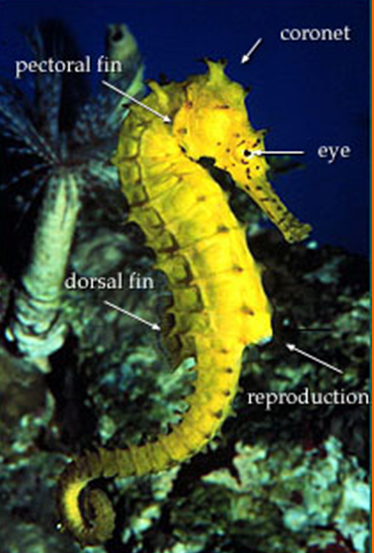Sea Horse Facts
Sea Horse Facts
1. Their scientific name is hippocampus. Something interesting about their name is that they are called sea horses because of the shape of their heads.Babies are called ponies. 2. Seahorses are fish. Seahorses are vertebrates, that means they have a backbone and it is also a fish because it has gills.
3. Their colors can be: white, black, green, orange or red and they can actually change colors! They are 6 to 8 inches.
4. Seahorses come in many different colors and can also change colors to camouflage itself in its environment.
5. Seahorses live in sea grass beds, mangroves, or coral reefs.
6. Seahorses live in most parts of the world.
7. A seahorse has no teeth or stomach. Seahorses food digest so quickly through their systems. They must eat every hour to stay alive.
8. Crabs, tuna fish, skates, and rays eat seahorses. Storms also hurt seahorses by casting them ashore. Some humans harvest seahorses to use as medicine.
9. Unlike human females, it is the male seahorse that takes care of the eggs until they hatch. Out of two thousand babies born to a pair of seahorses, only two will survive.
10. Each eye moves independently.
11. About 35 known species exist.
12. Like some humans, seahorses have only one partner for life.
13. The life cycle starts by the female laying her eggs. She will then take the eggs to the male. He keeps the eggs until they hatch. Then they grow up to be an adult.
14. Sea horses swim upright, drifting in the sea.
15. Some male sea horses die a few days after birth because of the dead ponies left in the pouch that rot and cause infection. The male carries the babies but does not care for them.
16. Sea horses use their tails to grab onto sea grasses and coral.
17. A sea horse's eyes are like a lizard's because one eye looks left and the other looks right.
18. A sea horse snaps at the prey that comes near. With its tube shaped mouth they create a vacuum that gets the food into its mouth.
19. They have bone plates that help protect their bodies.
20. If the population is stable, only two of thousands of young that a pair produces will reach maturity.
21. Sea horses utter musical sounds.



Comments
Post a Comment